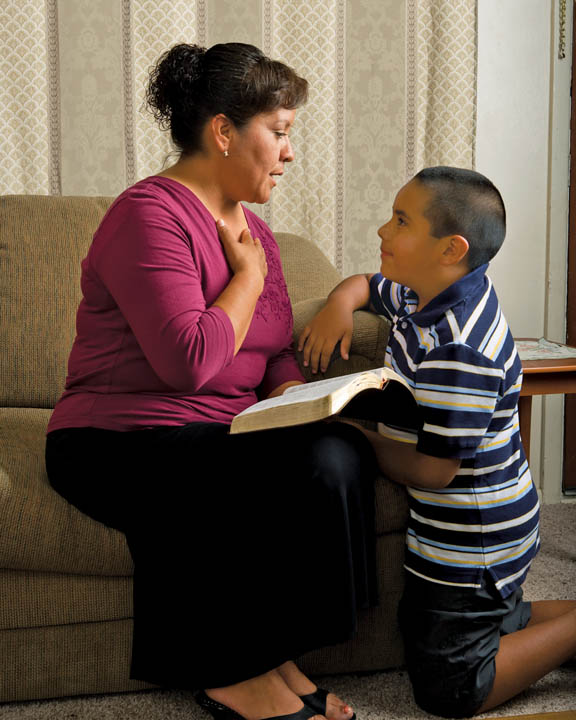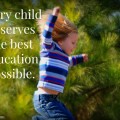School may be out, but there is no reason for the learning to stop. While religious education might be against the law in public schools, at home this summer, you can teach your children to love the scriptures, and maybe sneak in a little academic learning at the same time.
 Summer learning should be very different from school year learning. No desks or worksheets this summer-keep it fun and interactive. Start by deciding what you want to accomplish. Do you want your children to gain an overall knowledge of Bible stories or do you want to focus on one story or even a theme? Perhaps you want your children to learn why it matters that they obey the commandments, so you’ll choose stories that teach this principle. Or, if you’re hoping to get a lot of academics in, you might choose a story that leads to some interesting academic studies. For instance, a study of Noah’s ark can teach religious principles while being the center of a summer spent studying animals.
Summer learning should be very different from school year learning. No desks or worksheets this summer-keep it fun and interactive. Start by deciding what you want to accomplish. Do you want your children to gain an overall knowledge of Bible stories or do you want to focus on one story or even a theme? Perhaps you want your children to learn why it matters that they obey the commandments, so you’ll choose stories that teach this principle. Or, if you’re hoping to get a lot of academics in, you might choose a story that leads to some interesting academic studies. For instance, a study of Noah’s ark can teach religious principles while being the center of a summer spent studying animals.
Make a list of the stories you want to teach and create a box for each one. Begin gathering materials that can be used to make the learning fun. One place to get ideas is from the Mormon children’s magazine, The Friend. There are many Bible stories in this magazine that are applicable to people of any religion, and there are also games, coloring pages, puzzles, flannel board stories, and related stories.
Here’s an example of a few things you could use to create a summer program on Noah’s Ark from the Mormon website. Note that most things are not specific to Mormons.
1. The story in pictures
2. A missing word puzzle
3. A rhebus and a telling of the story with a story stage so the children can use the pictures to act out the story.
4. A flannel board story
5. A finger play, a recipe, and animal jingles
There are many more, but this gives you an idea of what is available for use in your home Vacation Bible School. A fun learning experience will include crafts, food, games, puzzles, and imagination.
Decide when your class will be held. It helps to have a regular schedule so it doesn’t get pushed aside in the rush of summer. You don’t have to do it every day-one day a week is plenty if that’s all you’re up to, or even just a week every month of summer. You’ll find though, that there are many things you can do that aren’t officially in the program, but that can be part of it, such as going to the zoo while you’re studying Noah’s Ark.
Choosing a basic pattern for the class will make planning simpler. This way you need only plug in an appropriate activity. This is a sample outline:
1. Prayer
2. Songs
3. Story (tell the story in a different way each time you tell it-orally, flannel board, book, etc. There are many books based on this story, and if you’re doing it for a long time, it can be fun to compare them.)
4. Activity-puppet show, games, service project, for instance.
5. Craft
6. Academic portion if desired.
7. Treat
8. Songs and prayer.
All of this can take one to two hours, depending on the craft and the activity and as you can see, it’s very participatory. Now, how does it work in actual practice? Let’s go back to our Noah’s Ark lesson.
Songs: There are a number of songs about Noah’s ark, and also a number of animal songs. You might want to use one spiritual song to prepare for the prayer and then have a singing time of fun songs after the prayer.
Story: Give the children a Noah’s Ark toy set with movable parts. First tell the story, perhaps using a story book, and then let them retell the story with their toys. This allows you to find out what they remember. Afterwards, discuss one message the story teaches, such as obedience to God. Make it a real discussion, not a lecture. You’ll be surprised to find out what your children think about this subject, so ask lots of questions that require an opinion, and then show respect for those opinions, so they aren’t afraid to continue offering them.
Activity: Put on music and have the children move like animals.
Craft: Make a jungle scene to be used later in the academic portion. The children might use a low box and put in real branches, grass, and leaves, and then draw animals on stiff paper and make them stand up.
Academic Portion: Watch a video on endangered animals and discuss how we, like Noah, have a responsibility to keep God’s creations from becoming extinct.
Treat: Animal crackers, of course. What else?
In the course of the morning, you’ve taught a scripture story and made certain the children understand the message. You’ve helped them play with the story in several ways, and you’ve tied it to a modern issue and a school subject. They’ve done reading, science, and art, but they haven’t spent even a minute at a desk.
Be sure to document your summer with pictures, videos, and maybe even a family blog they all take turns writing for. (This helps them improve their writing skills.) At the end of the summer, let them scrapbook the experience and print out the blog to become a journal of the experience. This will be a treasured memory when they grow up.
Finish your summer off with a spectacular activity-a themed party or field trip. Choose something that really wraps up the event and perhaps helps them to review what they’ve learned from their vacation Bible School at home.
If you need more ideas, visit homeschooling sites to see how they teach things in a fun way. Hands on learning stays with children much longer than formal book learning and doing it at home allows you to share your values with your children while they’re still young and forming their ideas and beliefs.
About Terrie Lynn Bittner
The late Terrie Lynn Bittner—beloved wife, mother, grandmother, and friend—was the author of two homeschooling books and numerous articles, including several that appeared in Latter-day Saint magazines. She became a member of the Church at the age of 17 and began sharing her faith online in 1992.





